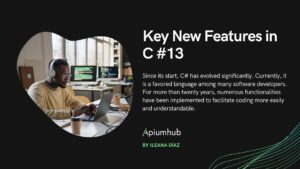Table of Contents
In the past few years, cloud computing has become a common word. In fact, According to the Worldwide Semiannual Public Cloud Services Spending Guide, worldwide spending on public cloud services will grow at a 19.4% CAGR, from almost $70 billion in 2015 to more than $141 billion in 2019 with companies investing in cloud services for new competitive advantages. This article explores cloud computing trends that will define the landscape of cloud computing in the coming years, from edge computing to quantum computing and the implications for businesses and technology enthusiasts.
Cloud Computing Trends: What is Cloud Computing?
To summarize, it’s more or less when you store data and programs on a cloud instead of storing it on the hard drive of a computer. What do you need to access the data? An internet connection. So yes, it’s about sharing, storing, processing, and managing resources delivered over a network of remote servers hosted on the Internet.
Cloud computing has undergone a remarkable evolution since its inception, transforming the way businesses and individuals leverage computing resources. As technology advances, innovations are shaping the future of cloud computing trends.
The Evolution of Cloud Computing Trends
Edge Computing Redefining Latency
Edge computing is poised to revolutionize cloud architecture by decentralizing computing power. Rather than relying solely on centralized data centers, edge computing distributes computational processes closer to the source of data generation. This paradigm shift significantly reduces latency, making real-time processing feasible for applications such as the Internet of Things (IoT), autonomous vehicles, and augmented reality.
Technical Example: Edge Computing in IoT
- Scenario: In an IoT deployment, edge computing processes sensor data locally on edge devices, reducing latency and bandwidth usage.
- Implementation: Using edge computing frameworks like AWS IoT Greengrass or Azure IoT Edge to deploy machine learning models directly on edge devices for real-time data analysis.
Quantum Computing: A Paradigm Shift in Processing Power
Quantum computing represents the next frontier in computational capability. Harnessing the principles of quantum mechanics, quantum computers have the potential to solve complex problems exponentially faster than classical computers. While quantum cloud services are in their infancy, they hold the promise of revolutionizing fields such as cryptography, optimization, and simulation.
Technical Example: Quantum Cloud Computing
- Scenario: Quantum cloud services leverage quantum processors to solve complex problems like factorization or optimization.
- Implementation: Integrating quantum cloud platforms such as IBM Quantum or Microsoft Azure Quantum to execute quantum algorithms for tasks that surpass classical computing capabilities.
Serverless Computing: Event-Driven Efficiency
Serverless computing, often referred to as Function as a Service (FaaS), allows developers to execute code in response to specific events without managing the underlying infrastructure. This event-driven model enhances efficiency, scalability, and cost-effectiveness. As serverless frameworks mature, they are becoming integral components of cloud ecosystems, enabling developers to focus on code rather than infrastructure management.
Technical Example: Serverless Computing with AWS Lambda
- Scenario: A serverless architecture dynamically scales resources in response to events, such as incoming requests or changes in data.
- Implementation: Deploying functions using AWS Lambda, triggered by events, eliminating the need for managing servers and allowing developers to focus on writing code.
Multi-Cloud and Hybrid Cloud Strategies
The future of cloud computing is increasingly characterized by multi-cloud and hybrid cloud approaches. Organizations are leveraging services from multiple cloud providers to avoid vendor lock-in, enhance redundancy, and optimize costs. Hybrid cloud architectures, combining on-premises infrastructure with cloud resources, provide flexibility and enable seamless integration of legacy systems with modern cloud services.
Technical Example: Multi-Cloud Deployment with Kubernetes
- Scenario: An organization uses Kubernetes for container orchestration, enabling seamless deployment and management of applications across multiple cloud providers.
- Implementation: Utilizing tools like Google Anthos or Azure Arc to manage Kubernetes clusters across different cloud environments, providing a unified control plane.
Innovations in Cloud Security
Zero Trust Architecture
The traditional perimeter-based security model is evolving towards a Zero Trust Architecture. This approach assumes that no entity, whether inside or outside the network, should be trusted by default. Identity verification is required from everyone trying to access resources, reducing the risk of unauthorized access and lateral movement within networks.
Technical Example: Zero Trust Architecture with BeyondCorp
- Scenario: BeyondCorp implements a Zero Trust model, requiring verification for every device and user attempting to access resources, regardless of their location.
- Implementation: Implementing BeyondCorp principles using identity and access management tools, such as Google Cloud Identity-Aware Proxy or Microsoft Azure Active Directory Conditional Access.
Confidential Computing
Confidential computing addresses the challenge of securing data during processing. This emerging paradigm ensures that data remains encrypted even when in use by applications or algorithms. By safeguarding sensitive information during computation, confidential computing enhances the privacy and security of data in cloud environments.
Technical Example: Confidential Computing with Intel SGX
- Scenario: Confidential computing ensures data remains encrypted during processing, preventing even the cloud provider from accessing sensitive information.
- Implementation: Leveraging hardware-based security features like Intel Software Guard Extensions (SGX) to create secure enclaves for confidential data processing.
AI-Driven Security Analytics
Artificial Intelligence (AI) is playing a pivotal role in enhancing cloud security. AI-driven security analytics systems analyze vast datasets to detect patterns indicative of potential threats. This proactive approach enables rapid identification and response to security incidents, bolstering the resilience of cloud infrastructures.
Technical Example: AI-Driven Security Analytics with Splunk
- Scenario: Security information and event management (SIEM) solutions powered by AI analyze logs and network data to detect and respond to security threats.
- Implementation: Deploying solutions like Splunk using machine learning algorithms to identify patterns indicative of potential security incidents, enhancing proactive threat detection.
Blockchain for Enhanced Trust and Transparency
Blockchain technology is finding applications beyond cryptocurrencies, with its decentralized and tamper-resistant nature being leveraged for secure and transparent cloud transactions. From identity management to ensuring the integrity of supply chain data, blockchain enhances trust and accountability in cloud-based interactions.
Technical Example: Blockchain for Cloud-Based Identity Management
- Scenario: Blockchain is used to create a decentralized and tamper-resistant identity management system, providing secure and transparent authentication.
- Implementation: Integrating blockchain solutions like Hyperledger Fabric or Ethereum for building decentralized identity verification systems in cloud applications.
The Future of Cloud-Native Development
Kubernetes and Container Orchestration
Kubernetes, an open-source container orchestration platform, has become synonymous with cloud-native development. The future sees continued growth in Kubernetes adoption, enabling developers to deploy, scale, and manage containerized applications seamlessly across diverse cloud environments.
Technical Example: Kubernetes for Cloud-Native Development
- Scenario: Kubernetes orchestrates containers in a cloud-native application, providing scalability and resilience.
- Implementation: Using Kubernetes to deploy, scale, and manage containerized applications across cloud providers, ensuring consistent application performance and resource utilization.
Progressive Web Applications (PWAs) and Serverless Architectures
The combination of Progressive Web Applications (PWAs) and serverless architectures represents a trend toward lightweight, scalable, and responsive web applications. By leveraging serverless computing, developers can build and deploy PWAs more efficiently, providing users with enhanced experiences without compromising on performance.
DevSecOps: Integrating Security into DevOps Practices
DevSecOps integrates security practices into the DevOps workflow, ensuring that security is not an afterthought but an integral part of the development process. The future of cloud-native development emphasizes a proactive and collaborative approach to security, enabling organizations to deliver secure and resilient applications.
Technical Example: DevSecOps Integration with Jenkins
- Scenario: DevSecOps integrates security practices into the continuous integration/continuous deployment (CI/CD) pipeline, ensuring security is embedded throughout the development lifecycle.
- Implementation: Incorporating security scans into Jenkins pipelines to identify vulnerabilities and compliance issues early in the development process.
Types of Cloud Computing: Private, Public and Hybrid
Private Clouds
A private cloud is when an infrastructure is either hosted on-site on a company’s intranet or hosted in the data center of a service provider and the resources are not shared with other organizations. We use it to increase storage capacity and the power of the processor. It is often used by big companies with large amounts of data or that have strict regulations about their data and certain types of regulations. The main advantage of going for a private cloud is that it offers a higher level of control and security. Also, it’s more customizable and therefore adapts to the specific IT requirements of companies. In general, the disadvantage would be that the maintenance and management is part of the responsibility of the company.
Public Clouds
On the public cloud, the data of a company is stored in the data center of a third-party provider, on shared hardware, and the storage and processor capacity are not owned by that company. Usually, small to medium-sized companies use public cloud computing due to the various advantages it provides them; as it’s not their hardware, it implies that there are no maintenance costs to the client and that they are not responsible for the management. Another advantage is that the time it takes for testing & deploying is decreased. It delivers agility, scalability, and efficiency. Although security breaches are kind of rare, some businesses get scared off by them when it comes to the public cloud.
Hybrid Clouds
The name is quite clear, hybrid cloud is a mix of private & public cloud services, it’s almost as if you get the best of both! What it does is that it allows you to move between both clouds and enables you to leverage the beast of what each one offers. The main advantage is that you get huge flexibility and much more options, you can for example put the most critical operations on the private cloud and the rest on the public, increasing your agility.
5 Benefits of Cloud Computing
Enough with cloud computing trends! By now you must have understood that with cloud computing you get many benefits. In a way you are enabling access to data from almost anywhere and with the growth of digital devices around us, we are just making it all more efficient and available. Here are the five main benefits of cloud computing:
1 – Software Update
With purchased software, you usually get yearly releases but when you’re using cloud computing services, it’s easy, you can get an upgraded system immediately. So you get the latest versions when they are released, including new features and functionalities that are on a regular base and with the latest technology. This can mean that you get up-to-date versions of software and upgrades to servers and processing power.
2 – Reduce Costs
Yes, you reduce the costs. Different costs. First of all, as companies have smaller (or none) data centers by using cloud computing, it implies that you reduce costs because you don’t need to buy equipment, hardware, facilities, utilities, etc. you reduce the number of servers and software costs. Other than that, you are also lowering the staff costs and system maintenance costs.
3 – Flexible Employees
Granting access to your employees means that you are boosting their flexibility. You can access, edit, and share data from anywhere you are because you only need a device and an internet connection (some apps even work offline). Most employees are quite happy when they know that they can take their work anywhere. Happy employees mean higher productivity.
4 – Flexible Capacity
It’s much more flexible. You can play with your capacity, and scale up or down your storage following your specific needs, may they be changing or not. If your needs increase or decrease, you don’t need to worry about it.
5 – Security
All businesses want to protect their data. There are many situations, that might rarely happen, but when they do, represent a tremendous problem, natural disasters or power failures. Well with the cloud, everything is backed up in a secure place. This means that you can always access your data unless your device is broken or you have no connection. But that’s not as big of a problem as losing the whole data, you just need to get another device. Your data is in the cloud, you can access it no matter what happens to your machine.
Cloud Computing Trends: Conclusion
The future of cloud computing trends is dynamic, driven by continuous innovation and the ever-evolving demands of the digital landscape. Edge computing, quantum computing, serverless architectures, and advanced security measures are reshaping how organizations leverage cloud resources. As the cloud-native development paradigm matures, businesses must stay agile, adopting emerging technologies to stay competitive and secure in an increasingly interconnected world.
In conclusion, the cloud computing trends and innovations outlined here paint a picture of a cloud computing landscape that is not only more powerful and flexible but also more secure and user-centric. As we embark on this transformative journey, collaboration between industry leaders, developers, and security professionals will be crucial in defining and realizing the full potential of the future cloud computing ecosystem.
Author
-

I am a Computer Engineer by training, with more than 20 years of experience working in the IT sector, specifically in the entire life cycle of a software, acquired in national and multinational companies, from different sectors.
View all posts











